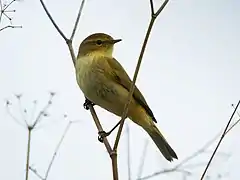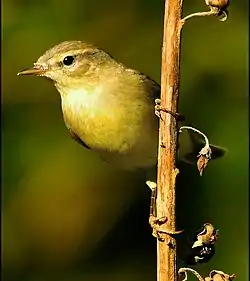イベリアチフチャフ
イベリアチフチャフ(学名:Phylloscopus ibericus)は、ムシクイ科に分類される鳥である。イベリア半島やアフリカ大陸に生息する。小さい体の上部は緑がかっていて、体の下部と顔は黄色がかっている。見た目はチフチャフに似ているが、イベリアチフチャフはより鮮やかな色をしている。主に虫を食べる。
| イベリアチフチャフ | |||||||||||||||||||||||||||
|---|---|---|---|---|---|---|---|---|---|---|---|---|---|---|---|---|---|---|---|---|---|---|---|---|---|---|---|
 | |||||||||||||||||||||||||||
| 保全状況評価[1] | |||||||||||||||||||||||||||
| LEAST CONCERN (IUCN Red List Ver.3.1 (2001))  | |||||||||||||||||||||||||||
| 分類 | |||||||||||||||||||||||||||
| |||||||||||||||||||||||||||
| 学名 | |||||||||||||||||||||||||||
| Phylloscopus ibericus Ticehurst, 1937 | |||||||||||||||||||||||||||
| シノニム | |||||||||||||||||||||||||||
|
Phylloscopus brehmii | |||||||||||||||||||||||||||
| 和名 | |||||||||||||||||||||||||||
| イベリアチフチャフ |
分類
当初イベリアチフチャフはPhylloscopus collybita brehmiiというチフチャフの亜種と考えられていたが、後の研究で両者のDNAが4.6パーセント異なっていることが明らかになり、別種であることが判明した[2][3][4]。このときこの種にはPhylloscopus brehmiiという学名がつけられたが、さらに後の研究でこのとき調査した個体がイベリアチフチャフではなく若いチフチャフであったことが判明し、最終的にイベリアチフチャフにはPhylloscopus ibericusという学名がつけられた[5][6]。
イベリアチフチャフは他のメボソムシクイ属よりも古い種で、およそ200万年前にチフチャフから種分化し、間氷期にチフチャフがイベリア半島に戻ってくる前の更新世にイベリア半島で他の種から孤立したと考えられている[2][7]。
特徴

体長10-11センチメートル程度、体重は7-8.25グラム程度と小さい。体の上部は緑がかっているが、体の下部と顔は黄色がかっている。外見はチフチャフにとてもよく似ているが、イベリアチフチャフはより鮮やかな色をしていて、尾の付け根や肩はより強い緑色をしている。顔や喉のあたりの黄色もイベリアチフチャフの方が鮮やかである[4][8]。翼はチフチャフよりもとがっていて、尾はイベリアチフチャフの方が少し長い[8][9]。脚は茶色をしている個体が多い。とてもよく似ているため外見から性別を見分けることは難しい。チフチャフと外見はよく似ているが、鳴き声は全く違う[2][10][11]。
分布
イベリア半島とアフリカ北部に分布する。ヨーロッパに36万から53万羽生息していると考えられており、これは全世界の個体数の約90パーセント程度とされている。この中でもスペインに最も多く分布しており、34万から40万羽が生息している[12]。大きな移動をしない個体もあるが、多くは冬になると渡り鳥としてサハラ砂漠を渡りアフリカ西部にまで達し[13]、セネガル、マリ南部、ブルキナファソ、ガーナ北部にまで到達する。
繁殖
繁殖期は2月から3月ごろに始まり、9月ごろまで続く。4個から7個程度の卵を産み13日から15日間で孵化する。
出典
- BirdLife International (2009). "Phylloscopus ibericus". IUCN Red List of Threatened Species. Version 2008. International Union for Conservation of Nature. 2010年10月13日閲覧。
- Andreas J. Helbig, Jochen Martens, I. Seibold, F. Henning, B. Schottler, Michael Wink (1996). “Phylogeny and species limits in the Palearctic Chiffchaff Phylloscopus collybita complex” (英語) (PDF). Ibis 138: pp. 650-666. 2009年6月5日閲覧。.
- Andreas J. Helbig, Marc Salomon, S. Bensch, I. Seibold, Male-biased gene flow across an avian hybrid zone: evidence from mitochondrial and microsatellite DNA. Journal of Evolutionary Biology, 2001.
- Collinson, J. Martin; Melling, Tim (April 2008). “Identification of vagrant Iberian Chiffchaffs - pointers, pitfalls and problem birds”. British Birds 101 (4): pp. 174-188..
- Salomon, M. Voisin, J.F. y Bried, J.(2003年1月) "On the taxonomic status and denomination of the Iberian Chiffchaffs" Ibis 145 (1): pp. 87–97..
- Lars Svensson, "The correct name of the Iberian Chiffchaff Phylloscopus ibericus Ticehurst 1937, its identification and new evidence of its winter grounds". Bulletin of the British Ornithologists Club, 2001
- Balmori, Alfonso; Cuesta, Miguel Ángel; Caballero, José María (2002): Distribución de los mosquiteros ibéricos (Phylloscopus brehmii) y europeo (Phylloscopus collybita) en los bosques de ribera de Castilla y León (España). Ardeola 49(1): pp. 19–27.
- Kevin Baker (1997) (英語). Warblers of Europe, Asia and North Africa (Helm Identification Guides). pp. 256–259. ISBN 0713639717
- Marc Salomon, J. Bried, Andreas J. Helbig, J. Riofrío, Morphometric differentiation between male Common Chiffchaffs, Phylloscopus [c.] collybita Vieillot, 1817, and Iberian Chiffchaffs, P. [c.] brehmii Homeyer, 1871, in a secondary contact zone (Aves: Sylviidae). Zoologischer Anzeiger, 1997.
- Salomon, Marc (1989): Song as a possible reproductive isolating mechanism between two parapatric forms. The case of the chiffchaffs Phylloscopus c. collybita and P. c. brehmii in the western Pyrenees. Behaviour 111 (1–4): pp. 270–290.
- Marc Salomon, Y. Hemim, Song variation in the Chiffchaffs (Phylloscopus collybita) of the western Pyrenees – the contact zone between collybita and brehmii forms. Ethology
- Hans-Günther Bauer, Einhard Bezzel und Wolfgang Fiedler (2005). Das Kompendium der Vögel Mitteleuropas: Alles über Biologie, Gefährdung und Schutz. Band 2: Passeriformes – Sperlingsvögel, Aula-Verlag Wiebelsheim, Wiesbaden. P. 193 ISBN 3-89104-648-0
- Catry, P. Lecoq, M. Aráujo, A. Conway, G. Felgueiras, M. J. Michael B. King, Rumsey, S. Salima H. y Tenreiro, P. Differential migration of chiffchaffs Phylloscopus collybita and P. ibericus in Europe and Africa PP. 184-190. Journal of avian biology 36 (2005)
- Andreas J. Helbig, Marc Salomon, Michael Wink, Joël Bried, Absence de flux genique mitochondrial entre le Pouillots "veloces" medio-européen et ibérique (Aves: Phylloscopus collybita, P. (c.) brehmii); implications taxonomiques. Résultats tirés de la PCR et du séquencage d'ADN. C. R. Acad. Sci. III, 1993.